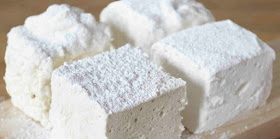Yields: 48 Marshmallows
INGREDIENTS:
10 sheets gelatin
1- 1/2 cups sugar
1/2 cup plus 2 tablespoons honey
1/2 cup glucose
3 egg whites
Confectioners’ sugar
Bee pollen
PREPARATION PROCEDURE:
1) Spray a 9 by 13-inch baking pan with nonstick vegetable cooking spray.
2) Bloom the gelatin by soaking the sheets in a bowl of ice water for 10 minutes until pliable.
3) Combine the granulated sugar, honey, and glucose with 1/2 cup of water in a heavy-bottomed saucepan over medium-high heat and bring to a boil, stirring to dissolve the sugar. Continue cooking without stirring until the mixture reaches the soft-ball stage (240°F.)
4) Meanwhile, place the egg whites in the bowl of a stand mixer fitted with the whisk attachment.
5) When the sugar syrup has reached 230°F, begin to whip the egg whites at medium speed to medium peaks.
6) When the sugar syrup reaches 240°F, gradually stream it into the egg whites with the mixer running on medium speed. As soon as all of the syrup has been incorporated, increase the speed to high. Squeeze the gelatin to remove any excess moisture, add to the warm meringue, and continue to whip until the mixture is slightly cool but still spreadable.
7) Pour into the prepared pan and smooth with an offset spatula. Cool at room temperature.
8) Wrap with plastic wrap and store overnight at room temperature, keeping the marshmallow away from moisture.
9) The next day, spray a knife with nonstick vegetable cooking spray and cut the marshmallow into 1½-inch pieces.
10) Turn out the marshmallows onto a cutting board dusted with confectioners’ sugar.
11) Coat on all sides with confectioners’ sugar, and then sprinkle with bee pollen.
Are you a vegetarian? Learn about the other alternatives for gelatin at... Functions of Gelling Agents in Food and Cooking: What Are the Alternatives for Vegetarians?
Quick Tips:
How to Convert Sheets of Gelatin to Grams or Weight
Unfortunately converting recipes from leaf to powdered gelatine is extremely tricky, as you cannot use a straight substitution based on weight. This is due to the strength of gelatin being very different. Sheet gelatin comes in different strengths (or grades) and the strength of the sheet gelatin is different to the powdered type.
Method 1:
You can effectively substitute sheet gelatin for powdered gelatin in any recipe by using the following scale.
1 (0.25 oz.) envelope granulated gelatin = 1 tablespoon powdered gelatin = 3 sheets leaf gelatin.
Gelatins are measured by what is called their Bloom strength (usually labeled as bronze, silver, gold, or platinum). Knox gelatine brand has a bloom strength of 225. If you are making a recipe, be it a Jell-O wreath or a pâté, you can use a different Bloom strength than what the recipe calls for, but you will have to do a little math.
You can convert the recipe to use whatever gelatin you have on hand if you know the weight (MA) and Bloom strength (BA). For gelatin A, you can find the equivalent weight of gelatin B (MB) with a Bloom strength of BB by using the formula MB = MA × BA ÷ BB.
For example, if a recipe calls for 2.6 g of Knox gelatin, you could use 3.7 g of silver gelatin, which has a Bloom strength of 160 (2.6 × 225 ÷ 160 = 3.7). To make a vegetarian panna cotta, we substitute 0.8 g agar and 0.65 g xanthan for the 4.3 g gelatin the recipe normally calls for.
Method 2:
As 15 sheets of gelatin sets 1.25 liters one sheet should set roughly 80ml (1/3 cup) liquid, two sheets 160ml (2/3 cup) and 3 sheets 250ml (1 cup) etc. So first see how many sheets are in the recipe and work out the amount of liquid this would set. At this point, you will need to look at your powdered gelatin and see what the package recommends in terms of amount of powder to set liquids and then use the amount you would need to set the same amount liquid that you have just calculated from the sheet gelatin.
For Knox gelatin a 1/4-ounce (7g) envelope contains 2 1/4 to 2 1/2 teaspoons powder and sets 2 cups liquid. So one envelope will be the equivalent of 6 sheets of gelatin.
When using powdered gelatine the method may need to be adjusted slightly too. Powdered gelatine usually needs to be soaked (sometimes called bloomed or sponged) in a little cold liquid first then warmed gently to dissolve it before adding it to the liquid to be set. Again, it is best to read and follow the instructions on the packaging of your gelatin.
CALORIE COUNTER for Homemade Marshmallows
Nutrition Facts
Serving Size 21.9g
Amount Per Serving
|
Calories 60
|
Calories from Fat 0
|
|
|
% Daily Value*
|
|
Total
Fat
0.0g
|
0%
|
|
Trans
Fat 0.0g
|
|
|
Cholesterol 0mg
|
0%
|
|
Sodium20mg
|
1%
|
|
Potassium3mg
|
0%
|
|
Total
Carbohydrates
15.2g
|
5%
|
|
Sugars 15.2g
|
|
|
Protein0.2g
|
|
Why Marshmallow is Good for You in Moderate Amount
1. Low in sodium
2. No cholesterol
3. No saturated fat
WATCH VIDEO: America's Test Kitchen DIY Marshmallows
Try this mouth-watering by 3 Michelin Starred Chef, Marcus Wareing. Get it NOW at, Vanilla Panna Cotta -Marcus Wareing Recipes

No comments:
Post a Comment